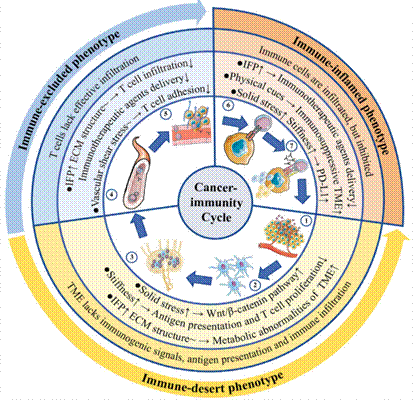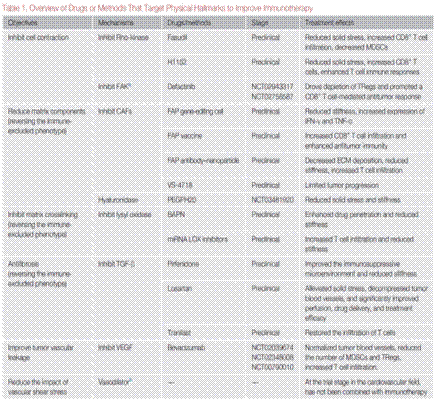Recently, Professor Guo Hui’s team from Department of Oncology of the First Affiliated Hospital of Xi 'an Jiaotong University (XJTU) cooperated with the team led by Professor Xu Feng fromBioinspired Engineering and Biomechanics Center (BEBC) of School of Life Science and Technology of XJTU to review a large quantity of latest research evidences and innovatively propose that physical cues in the tumor microenvironment, as new hallmarks of cancer, can synergistically lead to primary and secondary drug resistance in immunotherapy through multiple pathways. First, the rapid growth of tumors destroys the structure and function of surrounding tissues, leading to unique physical cues in the tumor microenvironment, such as increased matrix stiffness, elevated solid stress and interstitial fluid pressure, vascular shear stress with a wide range of changes, and the changes of extracellular matrix structure. Secondly, these physical cues not only affect the biological behavior of cancer cells, but also cause different categories of immune phenotypes in tumor microenvironment by interfering with the integrity of cancer-immunity cycle (Figure 1), thereby promoting tumor progression and affecting the tumor responsiveness to immunotherapy. Designing new targets according to physical hallmarks in tumor microenvironment (Table 1) may provide novel combined strategy for reversing immune resistance and improving clinical efficacy of immunotherapy, which holds great value inclinical application. In the future, new frontier technologies, such as cancer chip, immune engineering technology, cancer mathematical model and deep machine learning will be of remarkable significance for comprehensively exploring the physical cues in tumor microenvironment and developing combined immune therapy targeting physical factors.

Figure 1 Effect of physical cues in tumor microenvironment on cancer-immunity cycle and immune phenotype

Table 1 Overview of drugs and methods that target physical hallmarks to improve immunotherapy
The article entitled "Cancer Physical Hallmarks as New Targets for Improved Immunotherapy" was recently published in Trends in Cell Biology (IF=20.808),a research journal of Cell. Professor Guo Hui from Department of Oncology of the First Affiliated Hospital of XJTU is the first and corresponding author. Professor Xu Feng from School of Life Science and Technology of XJTU is the corresponding author. Zhang Tian and Yu Yang, two doctoral students from Department of Oncology of our hospital,are the co-authors of this article.
In recent years, Department of Oncology of our hospital has been dedicated to the research related to precision treatment of tumors. This article was completed with the support and assistance of the leaders and experts from Department of Oncology, providing novel ideas and directions for enhancing clinical efficacy for tumors by the integration of medicine and engineering and relevant translational research.